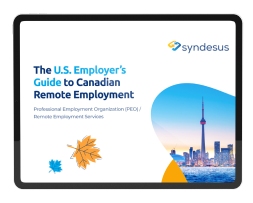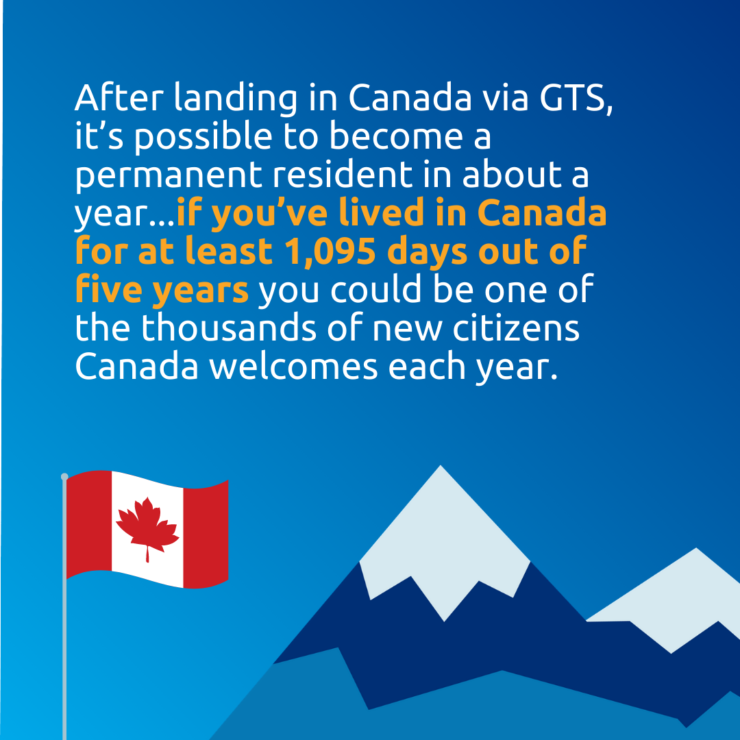On March 30, 2021, USCIS announced that it had completed the H-1B lottery and had selected registrations for FY 2022. Rumor has it that over 300,000 H-1B cap registrations were filed this year, and if that’s true, then the US passed last year’s H-1B registrations by at least 25,000!
If 300,000 people actually applied this year, that means that less than 30% of H-1B applicants were selected in the lottery, delivering a punch to the gut for over 200,000 folks looking for a chance to work and live in the US
The close of the H-1B visa registration process can spell disappointment for thousands of workers, but it also means that US companies are denied the skilled talent they need.
Sure, it’s possible to consider other options to keep working in the US — you could reapply for an H-1B, go back to school to get an F-1 student visa, test your luck with the expensive O-1 visa, or tie the knot with an American partner — but there’s a better more reliable option just north of the US border.
H-1B hopefuls should set their sights on Canada’s Global Talent Stream instead.
What is the Global Talent Stream?
Canadian tech companies were facing major roadblocks in hiring foreign workers to meet rising labor demands — which is a global issue — but the Canadian government introduced a solution: the Global Skills Strategy.
This program aims to help innovative companies grow by ensuring they can fast-track highly skilled talent into Canada. The Global Talent Stream — which is part of the Global Skills strategy — allows Canadian employers to expedite the hiring of foreign workers to fill specialized jobs when Canadian workers aren’t available.
In the past, foreign workers in Canada were required to obtain a work permit, a process that was often expensive and stressful for the hiring companies. The Global Skills Strategy program has created an exemption to the work permit requirement which means that some foreign nationals are now allowed to work in Canada without a work permit if they meet certain conditions.
But the best part of the Global Talent Stream (GTS) is the typically two-week processing time of applications for qualifying highly skilled talent. This speedy processing time was designed to get critical foreign talent to Canada FAST and to make Canada’s competitive employment landscape shine even brighter, providing a more effective and efficient immigration alternative for H-1B workers.
So how does GTS compare to the H-1B?
How does the Global Talent Stream compare to the H-1B visa?
If you are one of the lucky few who is selected in the H-1B lottery, you can expect to wait three months to one year for approvals. Now, compare that to GTS which takes 10 business days to assess applications and 14 business days to process work permits for qualified workers.
If you’re awarded an H-1B visa, you could possibly hold it for up to six years or more. Many then try for a green card, and finally to US citizenship. This entire process can take over a decade (or in some cases 150 years!) to get to permanent residence and then five more years to get citizenship. Sounds exhausting, right?
With GTS, on the other hand, once you’re a permanent resident, which can take less than a year, you can become a Canadian citizen in just five years. Currently, Canada prioritizes young, highly-skilled workers with Canadian experience for permanent immigration, and is aiming to welcome over 300,000 new immigrants each year, so participating in GTS is a smart way to set yourself up for a future in Canada.
As you can see, there are plenty of reasons to skip the H-1B drama, but here are the four best reasons to choose Canada’s GTS over America’s H-1B visa.
4 reasons to choose Canada’s Global Talent Stream over the H-1B visa program
If you are one of the thousands of H-1B candidates who didn’t get chosen in the lottery, you’re probably wondering, what’s next? How do you retain your job while navigating complicated immigration rules and regulations? The solution is Canada. Here are four reasons why you should consider relocating to Canada instead:
Reason 1: Canada is cheaper for both tech workers and tech employers
Living in the US isn’t cheap, especially if you live in a tech hub like Silicon Valley, NYC or even up-and-coming cities like Austin, TX. Living somewhere more affordable saves you and your employer money — from cost of living to benefits. Better yet, permanent residents in Canada enjoy the benefits of a government-run single-payer system. On average a Canadian spends $6,604 in taxes for healthcare coverage compared to more than an average of $10,000 per person that Americans spend on healthcare.
Reason 2: Canada is close to the US for in-person meetings
Once business travel picks up again, it’ll be simple for your Canada-based employer to send you across the border. If you stay on the same coast as your HQ, there won’t even be a time zone change.
Reason 3: TN status makes returning to the US from Canada easy
The TN visa makes returning to the States a breeze. The United States Mexico Canada Agreement (USMCA) — an updated version of the North American Free Trade Agreement (NAFTA) — simplifies the movement of workers from Canada and Mexico into the US The NAFTA visa category is known as a TN visa and gives professionals in sixty categories access to jobs across Canada, the US, or Mexico.
TN status enables North American workers to cross borders pretty easily, and TN visa holders are able to hop across the border for business trips and eventually legally re-enter the country easily. So once you become a Canadian citizen in about 5 years, you can re-enter the US to work on a longer-term basis with a TN visa.
Reason 4: Canadian immigration offers stability
After landing in Canada via GTS, it’s possible to become a permanent resident in about a year. Once you’re a permanent resident, it’s relatively easy to become a Canadian citizen – if you’ve lived in Canada for at least 1,095 days out of five years you could be one of the thousands of new citizens Canada welcomes each year. Currently, Canada prioritizes young, highly skilled workers with Canadian experience for permanent immigration, so participating in GTS is a smart way to set yourself up for a future in Canada.
As you can see, there are plenty of reasons to skip the H-1B drama and move up to Canada instead.
But how can your America-based company move you to Canada? And if they won’t support you, what other options do you have?
Reason 1: Canada is cheaper for both tech workers and tech employers
Living in the US isn’t cheap, especially if you live in a tech hub like Silicon Valley, NYC, or even up-and-coming cities like Austin, TX. Living somewhere more affordable saves you and your employer money — from the cost of living to benefits. Better yet, permanent residents in Canada enjoy the benefits of a government-run single-payer system. On average a Canadian spends $6,604 in taxes for healthcare coverage compared to more than an average of $10,000 per person that Americans spend on healthcare.
Reason 2: Canada is close to the US for in-person meetings
Once business travel picks up again, it’ll be simple for your Canada-based employer to send you across the border. If you stay on the same coast as your HQ, there won’t even be a time zone change.
Reason 3: TN status makes returning to the US from Canada easy
The TN visa makes returning to the States a breeze. The United States Mexico Canada Agreement (USMCA) — an updated version of the North American Free Trade Agreement (NAFTA) — simplifies the movement of workers from Canada and Mexico into the US The NAFTA visa category is known as a TN visa and gives professionals in sixty categories access to jobs across Canada, the US, or Mexico.
TN status enables North American workers to cross borders pretty easily, and TN visa holders are able to hop across the border for business trips and eventually legally re-enter the country easily. So once you become a Canadian citizen in about 5 years, you can re-enter the US to work on a longer-term basis with a TN visa.
Reason 4: Canadian immigration offers stability
After landing in Canada via GTS, it’s possible to become a permanent resident in about a year. Once you’re a permanent resident, it’s relatively easy to become a Canadian citizen – if you’ve lived in Canada for at least 1,095 days out of five years you could be one of the thousands of new citizens Canada welcomes each year. Currently, Canada prioritizes young, highly skilled workers with Canadian experience for permanent immigration, so participating in GTS is a smart way to set yourself up for a future in Canada.
As you can see, there are plenty of reasons to skip the H-1B drama and move up to Canada instead.
But how can your America-based company easily hire you in Canada? Simple, use a PEO.
Syndesus and Path to Canada help highly-skilled employees navigate Canadian immigration
Don’t lose your tech job due to US immigration issues. As we’ve discussed, Canada welcomes highly skilled tech workers.
Utilizing the Global Talent Stream, qualified tech workers can easily relocate to Canada. There are two pathways for those who are currently in the US:
1. With the support of your current US employer, you can relocate to Canada to work for them remotely.
2. If your American employer will not support your relocation, you can get matched with a Canadian company that is eager to have talented employees join their team and will support your move.
Sign-up for a FREE upcoming Live Info Session here with Syndesus and Path to Canada CEO and Founder, Marc Pavlopoulos and Canadian Immigration Lawyer, Daniel Mandelbaum to learn about how qualified highly-skilled tech workers can easily relocate to Canada and what options are available.








